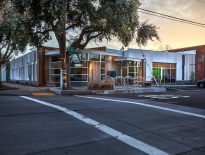The Living Community Challenge: Gaining Momentum
When the Institute launched the Living Building Challenge, it stretched people’s imagination about what is possible. Building on the success of the Living Building Challenge, the Living Community Challenge is helping people reimagine what good looks like in the public realm of our campuses, neighborhoods, and communities.
Higher education campuses have long been leaders in the creation of Living Buildings; now they are becoming leaders in the creation of Living Campuses.
The Living Community Challenge registered projects have tripled in the last two years. With this momentum, we are seeing an interest from communities of all scales. It is accessible to new infill projects and existing neighborhoods and campuses—in rural villages focused on preserving farmland—as well as in dense, existing urban neighborhoods who want to spark resilient, equitable, and regenerative development in their community. The program is a call to action to governments, campuses, planners, developers, and neighborhood groups to create communities that are vibrant, connected, and regenerative.
A growing trend in registered LCC projects is higher education campuses. As of Spring 2018, higher education campuses represent 25% of all registered LCC projects. Higher education campuses have long been leaders in the creation of Living Buildings; now they are becoming leaders in the creation of Living Campuses. The Living Building Challenge imagines a campus building that educates as a living laboratory. The Living Community Challenge imagines a campus full of such buildings, working together as an ecosystem. By optimizing lessons learned from the Living Building Challenge and seeking complete solutions beyond the building’s footprint using the Living Community Challenge, colleges and universities are taking a holistic approach to regenerative design and planning.
Campuses that embrace the Living Building and Living Community Challenges represent international leaders who have made a multi-generational commitment to climate solutions, resiliency, health, innovation, and equity. These institutions are taking a lead in connecting the next generation to a Living Future. For example, we are seeing curriculum focused on Biophilic Design helping kick-off the first LCC Biophilic Design day-long exploration that the Institute facilitated at our first campus to register for the Living Community Challenge, California State University Monterey Bay. Leading the way for registered LCC campuses on the east coast, Williams College is leveraging its certified Living Building Challenge catalyst project to target opportunities that are better solved at the campus scale such as material procurement and education through the built environment.
This summer has already included a flurry of activity for regenerative planning at the higher education scale. July 2018 has marked a new milestone for the Living Community Challenge program; California State University Monterey Bay (CSUMB) became the first LCC Vision Plan Compliant community/campus. CSUMB also received the California Higher Education Sustainability Conference (CHESC) Best Practice Award for Large-Scale Planning: Living Community Challenge Vision Plan.
“We looked at more than just the LCC framework initially, the campus determined that the LCC best supports the campus vision and mission and incorporate elements of social justice, beauty, and equity in a way that allows the campus to be more creative, flexible and visionary in its application of these elements.” Lacey Raak Sustainability Director, CSUMB
As more communities and campuses stretch their imaginations for what a sustainable, thriving future looks like to them, the Living Community Challenge will scale adoption as a visionary path to that regenerative future.



